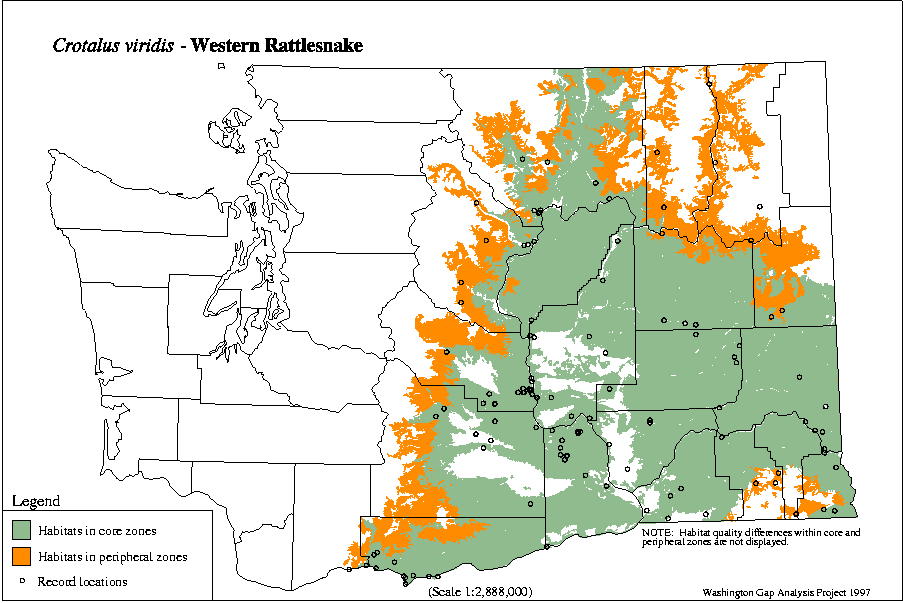Venomous snakes in Washington – What are the chances you’ll meet one?
You're hiking in Washington state. In the path ahead, a snake slithers into view. How worried should you be?
CPR Seattle’s Heartsaver First Aid class touches on what to do in the event of snakebite. Our Wilderness First Aid course also expands on the topic. Out of the dozen or so species of snakes that are native to Washington state, only one, the Western rattlesnake, is venomous enough to be of a hazard to humans. As they are not found in Western Washington, you can usually assume any snake you encounter in the greater Seattle area is not venomous to humans.
Common in eastern Washington, the Western rattlesnake may be encountered in proximity to their dens. These can often be found among rocks in areas open to sun exposure. Spring and fall hikers may find them out and active at dusk and dawn as the snakes move between hibernation spots.
 The rattlesnakes may range in size from juveniles of eighteen inches to four feet at adulthood. They can be identified by the wide triangular head, a diamond-shaped pattern of scales on the back, and of course, a rattle at the end of the tail. Note that rattlesnakes do not always rattle before they strike, nor do they always strike after they rattle. Coloration varies depending on habitat; look for a range from grey to greenish-brown.
The rattlesnakes may range in size from juveniles of eighteen inches to four feet at adulthood. They can be identified by the wide triangular head, a diamond-shaped pattern of scales on the back, and of course, a rattle at the end of the tail. Note that rattlesnakes do not always rattle before they strike, nor do they always strike after they rattle. Coloration varies depending on habitat; look for a range from grey to greenish-brown.
The venom of a rattlesnake is rarely delivered in a quantity fatal to humans; however painful swelling and tissue discoloration may occur at the bite location. Rattlesnakes cannot spit venom, but if a snake strikes a wire fence or similar object, venom may squirt from the snake’s open mouth. This is only a hazard if the venom contacts an open wound.
Rattlesnakes do not prey on humans; therefore they will not be likely to bite a human unless they feel threatened.
If you encounter one, or a snake you think is a rattlesnake, do not approach it. Look at the shape of the head and tail, as well as any markings and colors. If you identify the snake as a rattlesnake, leave the area and call a local wildlife control office or company, and have them attempt to collect the snake if necessary. If the snake has been killed, do not pick it up. Some snakes can still bite for several hours after they die, just from reflex alone. Always seek medical attention for any snake bite, especially if you suspect it to be from a venomous snake.
Symptoms commonly experienced immediately after a bite from a rattlesnake can include (but are not limited to):
- Nausea/vomiting
- Rapid heartbeat
- Feelings of panic
- Paralysis
- Numbness
- Breathing problems
- Blurred vision
Remember these first aid tips for venomous snake bites:
- Keep the patient calm. If they need to be moved, do so slowly and with frequent rest.
- Try to keep the wound below heart level (lower than the chest).
- Do not use a tourniquet.
- Do not cut the wound and/or attempt to suck the poison out.
- Do not apply ice to the wound.
- Do not administer food or drink (especially alcohol).
- Remove any clothing or items that may constrict a swelling limb.
- Do not administer electric shock (this was actually a remedy used in the past).
Most victims of snakebite make a complete recovery, with no lasting effects.
However, prevention is always better than treatment. Try to avoid areas where snakes hide, such as under rocks and logs. Do not handle any snake unless you have adequate training. Do not harass or threaten any snake. Use hiking poles or sticks to tap and probe ahead of your path when in snake country. Wear long pants and boots to minimize contact with wildlife. And always notify 911 or local emergency services if you feel in doubt or in danger.
(For some pictures of the Western rattlesnake, visit http://www.bentler.us/eastern-washington/animals/reptiles/snakes/rattlesnakes.aspx)
Map image via Washington Department of Fish and Wildlife
Enjoy our blog? follow us on Facebook.
Published on August 18, 2014
